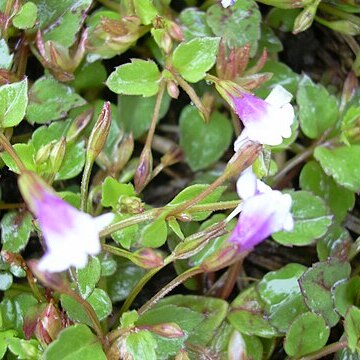Cal regular, the 5 sep separate nearly or quite to the base; cor bilabiate, the upper lip much narrower than the lower, erect, shallowly 2-lobed, the lower somewhat deflexed, 3-lobed; stamens 2 (the upper pair) or 4, the upper pair fertile, inserted at the middle of the cor-tube and included in it; lower pair of stamens sterile or fertile, inserted at the throat of the cor-tube, the basal part of the filament bent back on itself, the terminal part free, the whole resembling a forked filament; style elongate; stigmas 2, plate-like; fr fusiform to ellipsoid, commonly asymmetrical, septicidal; small annual (ours) or biennial herbs with opposite, 3–5-nerved, entire or denticulate lvs and small, white to violet fls on solitary, axillary, bractless peduncles. (Ilysanthes) 70, cosmop.
Herbs, erect, prostrate, or creeping. Leaves opposite; petiolate or sessile; leaf blade margin often toothed or rarely entire; veins pinnate or palmate. Inflorescences terminal or axillary, racemose, sometimes pseudo-umbellate, rarely in large panicles, or flowers solitary. Flowers opposite or alternate, often pedicellate. Bracteoles absent. Calyx lobes 5, equal or subequal, parted, or split on 1 side. Corolla lower lip larger than upper, extended; upper lip erect. Stamens 4, all fertile or 2 anterior reduced and filaments appendaged; anthers coherent or apex of locules of anterior ones pointed or spurred. Style mostly 2-lamellate, apex often enlarged. Seeds small, numerous.
Stamens either 4, all antheriferous and fertile, or 2, with posterior pair fertile and anterior pair reduced to staminodes, posterior pairs affixed to corolla tube, anterior pair or staminodes arising in throat; frequently anterior filaments each with distinct spur arising at or near base; anthers free or contiguous, cells divaricate.
Calyx 5-lobed, shallowly lobed with lobes spreading or somewhat connivent when mature, or lobed almost to base with lobes lanceolate to linear-lanceolate; tube 5-nerved, each nerve with obscure or distinct rib or minute wing.
Leaves opposite to almost opposite, simple, sessile or petiolate, entire, crenate or toothed, pinnately nerved or 3–5-nerved with nerves arising at base of lamina.
Corolla tubular, bilabiate; anterior lip trilobed, lobes usually spreading; posterior lip either entire or emarginate to bilobed, suberect.
Stems slender, erect, prostrate or creeping and rooting at nodes, simple or more usually branched, obscurely to distinctly quadrangular.
Flowers solitary, axillary or terminal, or in terminal or axillary racemes or clusters, small, pedicellate or occasionally subsessile.
Capsule globose, ovoid, obovoid, ellipsoid, or cylindric to narrowly so, bivalved.
Annual or perennial herbs, glabrous, pubescent or subglandular.
Seeds numerous, smooth to alveolate, variously shaped.
Stigma bilamellate; style slender, erect.

